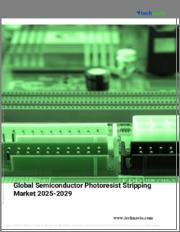
|
시장보고서
상품코드
1725168
세계의 DIY 포토레지스트 시장 예측(-2032년) : 유형, 용도, 최종 사용자, 지역별 분석DIY Photoresist Market Forecasts to 2032 - Global Analysis By Type, Application, End User and By Geography |
||||||
Stratistics MRC에 따르면 세계의 DIY 포토레지스트 시장은 2025년에 16억 8,000만 달러를 차지하고 예측 기간 중 CAGR은 5.6%로 확대되어 2032년까지 24억 7,000만 달러에 이를 전망입니다.
DIY 포토레지스트는 PCB 에칭이나 미세 가공 등의 공정에서 이용되는 자사 제조의 감광성 물질을 가리킵니다. 일반적으로, PVA(폴리비닐알코올)나 중크롬산칼륨 등, 입수하기 쉬운 화학물질로 구성되어 있습니다. 마스크를 통해 자외선을 조사하면 포토레지스트는 조사된 영역에서 고화됩니다.
개인화 전자 제품에 대한 수요 증가
커스터마이즈된 디바이스에 대한 요구가 높아짐에 따라 DIY 포토레지스트 업계를 크게 견인해 왔습니다. 메이커 무브먼트나 액세스 가능한 온라인 포럼의 출현으로 가정에서 전자 기기를 개조하는 개인이 늘어나 사용자 친화적이고 비용 효율적인 포토레지스트 키트 수요가 높아지고 있습니다.
기술 전문 지식 부족
DIY 포토레지스트 시장에서 중요한 한계는 예상 소비자의 기술적 숙련도가 부족합니다. 그리고 학습 곡선은 취미 사용자와 소규모 소비자가 DIY 포토 레지스트 솔루션을 채택하는 것을 망설일 수 있습니다.
교육기관과의 제휴
교육기관과의 제휴는 DIY 포토레지스트 분야에 큰 가능성을 제공합니다. 이를 통해 제조업체는 초보자 친화적 인 키트와 교재를 출시 할 수 있으며 기술에 대한 접근성이 높아집니다.
상업 제조업체와의 경쟁
상업 제조업체와의 경쟁은 DIY 포토레지스트 분야에 큰 리스크를 가져옵니다. 뛰어난 내구성과 성능을 제공하지만 DIY 솔루션은 이를 재현하기 어려울 수 있습니다. 그 결과, 이 시장은 특히 효율성과 품질을 중시하는 잠재적인 사용자를 확립된 상업적 경쟁자에게 빼앗겨 성장의 가능성을 제한할 위험이 있습니다.
COVID-19의 영향:
COVID-19의 유행은 DIY 포토레지스트 산업에 큰 영향을 미쳤습니다. 프로토타이핑이나 미세 가공에 임하는 개인의 수가 늘어나, DIY용 포토레지스트 킷 수요가 높아졌습니다. 또한 원격 학습이 교육 기관에 가정에서의 실천적인 과학 교육을 촉구해, 물류상의 장해에도 불구하고 시장의 회복력을 높이고 있습니다.
예측기간 동안 전자제품 분야가 최대화될 전망
예측 기간 동안 전자 제조 분야가 가장 큰 시장 점유율을 차지할 것으로 예측됩니다. 동향 증가와 맞춤형 전자 제품을 만드는 취미인과 중소기업의 인구 증가로 이익을 얻고 있습니다.
예측기간 중 소규모 및 신흥기업 부문의 CAGR이 가장 높아질 전망
예측 기간 동안 소규모 기업과 신흥 기업 부문이 가장 높은 성장률을 보일 것으로 예측됩니다. 들어갈 자금이 없을 수도 있고, DIY 포토레지스트 키트가 유력한 선택지가 되고 있습니다.
가장 높은 점유율이 있는 지역:
예측 기간 동안 아시아태평양이 가장 큰 시장 점유율을 차지할 것으로 예측됩니다. 현지 제조 능력과 경제적 소재에 대한 광범위한 접근에 참여하고 있으며, 아시아태평양에서는 취미와 소규모 비즈니스 인구가 증가하고 있으며 DIY 포토레지스트 솔루션에 대한 지속적인 요구가 보장되고 시장 점유율의 이점이 강화되고 있습니다.
CAGR이 가장 높은 지역:
예측 기간 동안 북미가 가장 높은 CAGR을 보여줄 것으로 예측됩니다. 저명한 전자상거래 플랫폼을 통해 DIY 키트에 쉽게 접근할 수 있는 것이, 애호가와 혁신가의 활기찬 커뮤니티가 시장 섭취를 대폭 촉진하고 있습니다. 또한 북미는 기술 혁신과 응용 STEM 교육에 중점을 두고 있기 때문에 이 지역이 시장 확대를 리드해, 세계 최대의 CAGR을 달성하고 있습니다.
무료 주문을 받아서 만드는 서비스:
이 보고서를 구독하는 고객은 다음 무료 맞춤설정 옵션 중 하나를 사용할 수 있습니다.
- 기업 프로파일
- 추가 시장 기업의 종합적 프로파일링(3개사까지)
- 주요 기업의 SWOT 분석(3개사까지)
- 지역 세분화
- 고객의 관심에 응한 주요국 시장 추계 및 예측, CAGR(주: 타당성 확인에 따름)
- 경쟁 벤치마킹
- 제품 포트폴리오, 지리적 존재, 전략적 제휴에 기반한 주요 기업 벤치마킹
목차
제1장 주요 요약
제2장 서문
- 개요
- 이해관계자
- 조사 범위
- 조사 방법
- 데이터 마이닝
- 데이터 분석
- 데이터 검증
- 조사 접근
- 조사 자료
- 1차 조사 자료
- 2차 조사 정보원
- 전제조건
제3장 시장 동향 분석
- 성장 촉진요인
- 억제요인
- 기회
- 위협
- 용도 분석
- 최종 사용자 분석
- 신흥 시장
- COVID-19의 영향
제4장 Porter's Five Forces 분석
- 공급기업의 협상력
- 구매자의 협상력
- 대체품의 위협
- 신규 참가업체의 위협
- 경쟁 기업간 경쟁 관계
제5장 세계의 DIY 포토레지스트 시장 : 유형별
- 포지티브 포토레지스트
- 네거티브 포토레지스트
제6장 세계의 DIY 포토레지스트 시장 : 용도별
- 전자기기 제조
- 인쇄회로기판(PCB)
- 전자부품
- 마이크로플루이딕스공학
- 3D 프린팅
- 교육 목적 및 STEM학습
- 취미 및 제조업체 프로젝트
제7장 세계의 DIY 포토레지스트 시장 : 최종 사용자별
- 취미 및 제조업체
- 교육기관
- 중소기업 및 스타트업
제8장 세계의 DIY 포토레지스트 시장 : 지역별
- 북미
- 미국
- 캐나다
- 멕시코
- 유럽
- 독일
- 영국
- 이탈리아
- 프랑스
- 스페인
- 기타 유럽
- 아시아태평양
- 일본
- 중국
- 인도
- 호주
- 뉴질랜드
- 한국
- 기타 아시아태평양
- 남미
- 아르헨티나
- 브라질
- 칠레
- 기타 남미
- 중동 및 아프리카
- 사우디아라비아
- 아랍에미리트(UAE)
- 카타르
- 남아프리카
- 기타 중동 및 아프리카
제9장 주요 발전
- 계약, 파트너십, 협업, 합작투자
- 인수와 합병
- 신제품 발매
- 사업 확대
- 기타 주요 전략
제10장 기업 프로파일링
- Tekscend Photomask
- Futurrex
- Chemtronics
- RS Components
- Adafruit Industries
- SparkFun Electronics
- AZ Electronic Materials
- Shipley
- Rohm and Haas Electronic Materials
- Sumitomo Chemical
- Tokyo Ohka Kogyo Co., Ltd
- JSR Corporation
- Fujifilm Holdings
- Shin-Etsu Chemical Co., Ltd
- Merck Group
- Micro Resist Technology
- DJ MicroLaminates
- LG Chem
According to Stratistics MRC, the Global DIY Photoresist Market is accounted for $1.68 billion in 2025 and is expected to reach $2.47 billion by 2032 growing at a CAGR of 5.6% during the forecast period. DIY photoresist describes a self-manufactured light-sensitive substance utilized in procedures such as PCB etching or microfabrication. It is generally composed of readily available chemicals, including PVA (polyvinyl alcohol) and potassium dichromate. Upon exposure to UV light via a patterned mask, the photoresist solidifies in the illuminated regions. Unexposed areas can then be eliminated, facilitating selective material removal or etching. It provides an economical substitute for commercial photoresists.
Market Dynamics:
Driver:
Growing demand for personalized electronics
The increasing need for customized devices is substantially driving the DIY photoresist industry. Consumers and small enterprises are increasingly pursuing tailored electronic solutions, resulting in heightened demand for rapid prototyping and custom PCB designs. Moreover, the emergence of the maker movement and accessible online forums has empowered more individuals to tinker with electronics at home, hence increasing the demand for user-friendly, cost-effective photoresist kits. This tendency guarantees ongoing innovation and expands the market's scope, positioning personalized electronics as a fundamental growth catalyst for the industry.
Restraint:
Lack of technical expertise
A significant limitation in the DIY photoresist market is the deficiency of technical proficiency among prospective consumers. The techniques involved, including coating, exposure, and etching, necessitate precision and a fundamental comprehension of microfabrication, which may be intimidating for novices. The intricacy and learning curve of these procedures may deter hobbyists and small-scale consumers from embracing DIY photoresist solutions. This constraint restricts the market's attractiveness, limiting its expansion mainly to individuals with prior experience or a robust desire to learn.
Opportunity:
Collaborations with educational institutions
Partnerships with educational institutions offer a significant possibility for the DIY photoresist sector. Bringing photoresist technologies into STEM classes and hands-on learning helps schools spark early interest and teach skills in microfabrication. Furthermore, these collaborations allow manufacturers to launch novice-friendly kits and instructional materials, enhancing the accessibility of the technology. This strategy not only fosters a new cohort of proficient users but also broadens the market's foundation, guaranteeing ongoing demand from both educators and learners.
Threat:
Competition from commercial manufacturers
Competition from commercial producers presents a substantial risk to the DIY photoresist sector. The accessibility of pre-manufactured PCBs and high-quality components at competitive prices frequently entices consumers who prioritize convenience and dependability over manual fabrication. Moreover, commercial items generally provide superior durability and performance, which DIY solutions may find challenging to replicate. Consequently, the market risks forfeiting potential users-particularly those who value efficiency and quality-to established commercial competitors, thereby limiting its growth potential.
Covid-19 Impact:
The Covid-19 epidemic exerted a significant influence on the DIY photoresist industry. Global supply chain disruptions and factory closures resulted in shortages and delays of raw materials, impeding timely access for hobbyists and small enterprises, while the lockdowns concurrently catalyzed an increase in home-based DIY activities. A growing number of individuals engaged in electronics prototyping and microfabrication initiatives, resulting in heightened demand for DIY photoresist kits. Moreover, remote learning prompted educational institutions to implement practical science instruction at home, enhancing market resilience despite logistical obstacles.
The electronics fabrication segment is expected to be the largest during the forecast period
The electronics fabrication segment is expected to account for the largest market share during the forecast period. This dominance is due to the important role of photoresists in making printed circuit boards (PCBs) and small electronic devices, which are essential for electronics production. Furthermore, the sector benefits from the escalating trend of quick prototyping and the rising population of hobbyists and small businesses creating custom electronics. The availability of DIY photoresist kits and online resources further consolidates the dominance of electronics fabrication as the primary application sector in the industry.
The small-scale enterprises and start-ups segment is expected to have the highest CAGR during the forecast period
Over the forecast period, the small-scale enterprises and start-ups segment is predicted to witness the highest growth rate. This swift growth is propelled by the demand for economical prototyping and specialized manufacturing solutions among nascent enterprises. Moreover, these firms sometimes lack the financial resources for substantial industrial equipment, rendering DIY photoresist kits a compelling alternative. The availability and cost-effectiveness of these kits allow small enterprises to innovate rapidly and effectively, setting this sector for the highest compound annual growth rate within the industry.
Region with largest share:
During the forecast period, the Asia Pacific region is expected to hold the largest market share. This growth is mainly attributable to the region's strong electronics manufacturing sector, emerging maker culture, and heightened emphasis on STEM education. Countries including China, Japan, South Korea, and India exhibit significant engagement in DIY electronics and microfabrication, bolstered by local manufacturing capacities and the extensive accessibility of economical materials. Moreover, the increasing population of hobbyists and small businesses in the Asia-Pacific region guarantees an ongoing need for DIY photoresist solutions, reinforcing their dominance in market share.
Region with highest CAGR:
Over the forecast period, the North America region is anticipated to exhibit the highest CAGR. The region's expansion is driven by a robust maker culture, sophisticated technology infrastructure, and extensive incorporation of photoresist technologies into educational curricula. Furthermore, the readily accessible DIY kits via prominent e-commerce platforms and a vibrant community of enthusiasts and innovators significantly enhance market uptake. In addition, North America's focus on innovation and applied STEM education guarantees that the area leads in market expansion, attaining the greatest CAGR worldwide.
Key players in the market
Some of the key players in DIY Photoresist Market include Tekscend Photomask, Futurrex, Chemtronics, RS Components, Adafruit Industries, SparkFun Electronics, AZ Electronic Materials, Shipley, Rohm and Haas Electronic Materials, Sumitomo Chemical, Tokyo Ohka Kogyo Co., Ltd, JSR Corporation, Fujifilm Holdings, Shin-Etsu Chemical Co., Ltd, Merck Group, Micro Resist Technology, DJ MicroLaminates and LG Chem.
Key Developments:
In November 2024, Tekscend Photomask Germany GmbH, in collaboration with The Advanced Mask Technology Center (AMTC), installed Europe's first Multibeam Mask Writer, the MBMW-100 Flex from IMS Nanofabrication. This innovative tool significantly reduces mask writing time for complex semiconductor designs from multiple days to just 7-12 hours.
In September 2024, Fujifilm announced a 20 billion yen investment to expand its semiconductor materials business in Japan. The investment focuses on enhancing facilities for the development, production, and quality evaluation of advanced semiconductor materials, including photoresists.
In August 2024, JSR revealed plans to establish a new photoresist development center in Japan and a semiconductor photoresist plant in Korea. These efforts aim to strengthen their global electronic materials business and support the commercialization of Metal Oxide Resist (MOR) for EUV lithography. The Korean plant is expected to begin operations in 2026.
Types Covered:
- Positive Photoresists
- Negative Photoresists
Applications Covered:
- Electronics Fabrication
- Microfluidics
- 3D Printing
- Educational Purposes/STEM Learning
- Hobbyist and Maker Projects
End Users Covered:
- Hobbyists and Makers
- Educational Institutions
- Small-Scale Enterprises and Startups
Regions Covered:
- North America
- US
- Canada
- Mexico
- Europe
- Germany
- UK
- Italy
- France
- Spain
- Rest of Europe
- Asia Pacific
- Japan
- China
- India
- Australia
- New Zealand
- South Korea
- Rest of Asia Pacific
- South America
- Argentina
- Brazil
- Chile
- Rest of South America
- Middle East & Africa
- Saudi Arabia
- UAE
- Qatar
- South Africa
- Rest of Middle East & Africa
What our report offers:
- Market share assessments for the regional and country-level segments
- Strategic recommendations for the new entrants
- Covers Market data for the years 2024, 2025, 2026, 2028, and 2032
- Market Trends (Drivers, Constraints, Opportunities, Threats, Challenges, Investment Opportunities, and recommendations)
- Strategic recommendations in key business segments based on the market estimations
- Competitive landscaping mapping the key common trends
- Company profiling with detailed strategies, financials, and recent developments
- Supply chain trends mapping the latest technological advancements
Free Customization Offerings:
All the customers of this report will be entitled to receive one of the following free customization options:
- Company Profiling
- Comprehensive profiling of additional market players (up to 3)
- SWOT Analysis of key players (up to 3)
- Regional Segmentation
- Market estimations, Forecasts and CAGR of any prominent country as per the client's interest (Note: Depends on feasibility check)
- Competitive Benchmarking
- Benchmarking of key players based on product portfolio, geographical presence, and strategic alliances
Table of Contents
1 Executive Summary
2 Preface
- 2.1 Abstract
- 2.2 Stake Holders
- 2.3 Research Scope
- 2.4 Research Methodology
- 2.4.1 Data Mining
- 2.4.2 Data Analysis
- 2.4.3 Data Validation
- 2.4.4 Research Approach
- 2.5 Research Sources
- 2.5.1 Primary Research Sources
- 2.5.2 Secondary Research Sources
- 2.5.3 Assumptions
3 Market Trend Analysis
- 3.1 Introduction
- 3.2 Drivers
- 3.3 Restraints
- 3.4 Opportunities
- 3.5 Threats
- 3.6 Application Analysis
- 3.7 End User Analysis
- 3.8 Emerging Markets
- 3.9 Impact of Covid-19
4 Porters Five Force Analysis
- 4.1 Bargaining power of suppliers
- 4.2 Bargaining power of buyers
- 4.3 Threat of substitutes
- 4.4 Threat of new entrants
- 4.5 Competitive rivalry
5 Global DIY Photoresist Market, By Type
- 5.1 Introduction
- 5.2 Positive Photoresists
- 5.3 Negative Photoresists
6 Global DIY Photoresist Market, By Application
- 6.1 Introduction
- 6.2 Electronics Fabrication
- 6.2.1 Printed Circuit Boards (PCBs)
- 6.2.2 Electronic Components
- 6.3 Microfluidics
- 6.4 3D Printing
- 6.5 Educational Purposes/STEM Learning
- 6.6 Hobbyist and Maker Projects
7 Global DIY Photoresist Market, By End User
- 7.1 Introduction
- 7.2 Hobbyists and Makers
- 7.3 Educational Institutions
- 7.4 Small-Scale Enterprises and Startups
8 Global DIY Photoresist Market, By Geography
- 8.1 Introduction
- 8.2 North America
- 8.2.1 US
- 8.2.2 Canada
- 8.2.3 Mexico
- 8.3 Europe
- 8.3.1 Germany
- 8.3.2 UK
- 8.3.3 Italy
- 8.3.4 France
- 8.3.5 Spain
- 8.3.6 Rest of Europe
- 8.4 Asia Pacific
- 8.4.1 Japan
- 8.4.2 China
- 8.4.3 India
- 8.4.4 Australia
- 8.4.5 New Zealand
- 8.4.6 South Korea
- 8.4.7 Rest of Asia Pacific
- 8.5 South America
- 8.5.1 Argentina
- 8.5.2 Brazil
- 8.5.3 Chile
- 8.5.4 Rest of South America
- 8.6 Middle East & Africa
- 8.6.1 Saudi Arabia
- 8.6.2 UAE
- 8.6.3 Qatar
- 8.6.4 South Africa
- 8.6.5 Rest of Middle East & Africa
9 Key Developments
- 9.1 Agreements, Partnerships, Collaborations and Joint Ventures
- 9.2 Acquisitions & Mergers
- 9.3 New Product Launch
- 9.4 Expansions
- 9.5 Other Key Strategies
10 Company Profiling
- 10.1 Tekscend Photomask
- 10.2 Futurrex
- 10.3 Chemtronics
- 10.4 RS Components
- 10.5 Adafruit Industries
- 10.6 SparkFun Electronics
- 10.7 AZ Electronic Materials
- 10.8 Shipley
- 10.9 Rohm and Haas Electronic Materials
- 10.10 Sumitomo Chemical
- 10.11 Tokyo Ohka Kogyo Co., Ltd
- 10.12 JSR Corporation
- 10.13 Fujifilm Holdings
- 10.14 Shin-Etsu Chemical Co., Ltd
- 10.15 Merck Group
- 10.16 Micro Resist Technology
- 10.17 DJ MicroLaminates
- 10.18 LG Chem



















